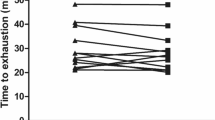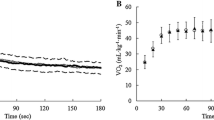Abstract
Purpose
Recent investigations have established that the ingestion of a moderate dose of caffeine (3–6 mg kg−1) can increase exercise and sports performance in women. However, it is unknown whether the ergogenicity of caffeine is similar during all phases of the menstrual cycle. The aim of this investigation was to determine the ergogenic effects of caffeine in three phases of the menstrual cycle.
Methods
Thirteen well-trained eumenorrheic triathletes (age = 31 ± 6 years; body mass = 58.6 ± 7.8 kg) participated in a double-blind, cross-over, randomised experimental trial. In the (1) early follicular (EF); (2) preovulation (PO); (3) and mid luteal (ML) phases, participants either ingested a placebo (cellulose) or 3 mg kg−1 of caffeine in an opaque and unidentifiable capsule. After a 60-min wait for substance absorption, participants performed an incremental maximal cycle ergometer test until volitional fatigue (25 W/min) to assess peak aerobic cycling power (Wmax).
Results
In comparison to the placebo, caffeine increased Wmax in the EF (4.13 ± 0.69 vs. 4.24 ± 0.71 W kg−1, Δ = 2.7 ± 3.3%, P = 0.01), in the PO (4.14 ± 0.70 vs. 4.27 ± 0.73 W kg−1, Δ = 3.3 ± 5.0%; P = 0.03) and in the ML (4.15 ± 0.69 vs. 4.29 ± 0.67 W kg−1, Δ = 3.6 ± 5.1%; P = 0.01) phases. The magnitude of the caffeine ergogenic effect was similar during all of the menstrual cycle phases (P = 0.85).
Conclusion
Caffeine increased peak aerobic cycling power in the early follicular, preovulatory, and mid luteal phases. Thus, the ingestion of 3 mg of caffeine per kg of body mass might be considered an ergogenic aid for eumenorrheic women during all three phases of the menstrual cycle.




Similar content being viewed by others
References
Souza DB, Del Coso J, Casonatto J, Polito MD (2017) Acute effects of caffeine-containing energy drinks on physical performance: a systematic review and meta-analysis. Eur J Nutr 56(1):13–27. https://doi.org/10.1007/s00394-016-1331-9
Glaister M, Gissane C (2018) Caffeine and physiological responses to submaximal exercise: a meta-analysis. Int J Sports Physiol Perform 13(4):402–411. https://doi.org/10.1123/ijspp.2017-0312
Grgic J (2018) Caffeine ingestion enhances Wingate performance: a meta-analysis. Eur J Sport Sci 18(2):219–225. https://doi.org/10.1080/17461391.2017.1394371
Salinero JJ, Lara B, Del Coso J (2018) Effects of acute ingestion of caffeine on team sports performance: a systematic review and meta-analysis. Res Sports Med. https://doi.org/10.1080/15438627.2018.1552146
Warren GL, Park ND, Maresca RD, McKibans KI, Millard-Stafford ML (2010) Effect of caffeine ingestion on muscular strength and endurance: a meta-analysis. Med Sci Sports Exerc 42(7):1375–1387. https://doi.org/10.1249/MSS.0b013e3181cabbd8
Conger SA, Warren GL, Hardy MA, Millard-Stafford ML (2011) Does caffeine added to carbohydrate provide additional ergogenic benefit for endurance? Int J Sport Nutr Exerc Metab 21(1):71–84
Grgic J, Grgic I, Pickering C, Schoenfeld BJ, Bishop DJ, Pedisic Z (2019) Wake up and smell the coffee: caffeine supplementation and exercise performance-an umbrella review of 21 published meta-analyses. Br J Sports Med. https://doi.org/10.1136/bjsports-2018-100278
Maughan RJ, Burke LM, Dvorak J, Larson-Meyer DE, Peeling P, Phillips SM, Rawson ES, Walsh NP, Garthe I, Geyer H, Meeusen R, van Loon LJC, Shirreffs SM, Spriet LL, Stuart M, Vernec A, Currell K, Ali VM, Budgett RG, Ljungqvist A, Mountjoy M, Pitsiladis YP, Soligard T, Erdener U, Engebretsen L (2018) IOC consensus statement: dietary supplements and the high-performance athlete. Br J Sports Med 52(7):439–455. https://doi.org/10.1136/bjsports-2018-099027
Salinero JJ, Lara B, Jimenez-Ormeno E, Romero-Moraleda B, Giraldez-Costas V, Baltazar-Martins G, Del Coso J (2019) More research is necessary to establish the ergogenic effect of caffeine in female athletes. Nutrients. https://doi.org/10.3390/nu11071600
Fett CA, Aquino NM, Schantz Junior J, Brandao CF, de Araujo Cavalcanti JD, Fett WC (2018) Performance of muscle strength and fatigue tolerance in young trained women supplemented with caffeine. J Sports Med Phys Fit 58(3):249–255. https://doi.org/10.23736/s0022-4707.17.06615-4
Goldstein E, Jacobs PL, Whitehurst M, Penhollow T, Antonio J (2010) Caffeine enhances upper body strength in resistance-trained women. J Int Soc Sports Nutr 7:18. https://doi.org/10.1186/1550-2783-7-18
Astorino TA, Roupoli LR, Valdivieso BR (2012) Caffeine does not alter RPE or pain perception during intense exercise in active women. Appetite 59(2):585–590. https://doi.org/10.1016/j.appet.2012.07.008
Lara B, Gonzalez-Millan C, Salinero JJ, Abian-Vicen J, Areces F, Barbero-Alvarez JC, Munoz V, Portillo LJ, Gonzalez-Rave JM, Del Coso J (2014) Caffeine-containing energy drink improves physical performance in female soccer players. Amino Acids 46(5):1385–1392. https://doi.org/10.1007/s00726-014-1709-z
Del Coso J, Portillo J, Munoz G, Abian-Vicen J, Gonzalez-Millan C, Munoz-Guerra J (2013) Caffeine-containing energy drink improves sprint performance during an international rugby sevens competition. Amino Acids 44(6):1511–1519. https://doi.org/10.1007/s00726-013-1473-5
Perez-Lopez A, Salinero JJ, Abian-Vicen J, Valades D, Lara B, Hernandez C, Areces F, Gonzalez C, Del Coso J (2015) Caffeinated energy drinks improve volleyball performance in elite female players. Med Sci Sports Exerc 47(4):850–856. https://doi.org/10.1249/MSS.0000000000000455
Skinner TL, Desbrow B, Arapova J, Schaumberg MA, Osborne J, Grant GD, Anoopkumar-Dukie S, Leveritt MD (2019) Women experience the same ergogenic response to caffeine as men. Med Sci Sports Exerc. https://doi.org/10.1249/MSS.0000000000001885
Lane SC, Hawley JA, Desbrow B, Jones AM, Blackwell JR, Ross ML, Zemski AJ, Burke LM (2014) Single and combined effects of beetroot juice and caffeine supplementation on cycling time trial performance. Appl Physiol Nutr Metab 39(9):1050–1057. https://doi.org/10.1139/apnm-2013-0336
Puente C, Abian-Vicen J, Salinero JJ, Lara B, Areces F, Del Coso J (2017) Caffeine improves basketball performance in experienced basketball players. Nutrients 9:9. https://doi.org/10.3390/nu9091033
Prins PJ, Goss FL, Nagle EF, Beals K, Robertson RJ, Lovalekar MT, Welton GL (2016) Energy drinks improve five-kilometer running performance in recreational endurance runners. J Strength Cond Res 30(11):2979–2990. https://doi.org/10.1519/jsc.0000000000001391
Abian P, Del Coso J, Salinero JJ, Gallo-Salazar C, Areces F, Ruiz-Vicente D, Lara B, Soriano L, Munoz V, Abian-Vicen J (2015) The ingestion of a caffeinated energy drink improves jump performance and activity patterns in elite badminton players. J Sports Sci 33(10):1042–1050. https://doi.org/10.1080/02640414.2014.981849
Gallo-Salazar C, Areces F, Abian-Vicen J, Lara B, Salinero JJ, Gonzalez-Millan C, Portillo J, Munoz V, Juarez D, Del Coso J (2015) Enhancing physical performance in elite junior tennis players with a caffeinated energy drink. Int J Sports physiol Perform 10(3):305–310. https://doi.org/10.1123/ijspp.2014-0103
Lara B, Ruiz-Moreno C, Salinero JJ, Del Coso J (2019) Time course of tolerance to the performance benefits of caffeine. PLoS One 14(1):e0210275. https://doi.org/10.1371/journal.pone.0210275
Sabblah S, Dixon D, Bottoms L (2015) Sex differences on the acute effects of caffeine on maximal strength and muscular endurance. Comp Exerc Physiol 11(2):89–94. https://doi.org/10.3920/CEP150010
Bruinvels G, Burden RJ, McGregor AJ, Ackerman KE, Dooley M, Richards T, Pedlar C (2017) Sport, exercise and the menstrual cycle: where is the research? Br J Sports Med 51(6):487–488. https://doi.org/10.1136/bjsports-2016-096279
Kamimori GH, Joubert A, Otterstetter R, Santaromana M, Eddington ND (1999) The effect of the menstrual cycle on the pharmacokinetics of caffeine in normal, healthy eumenorrheic females. Eur J Clin Pharmacol 55(6):445–449
McLean C, Graham TE (2002) Effects of exercise and thermal stress on caffeine pharmacokinetics in men and eumenorrheic women. J Appl Physiol (Bethesda, Md: 1985) 93(4):1471–1478. https://doi.org/10.1152/japplphysiol.00762.2000
Magkos F, Kavouras SA (2005) Caffeine use in sports, pharmacokinetics in man, and cellular mechanisms of action. Crit Rev Food Sci Nutr 45(7–8):535–562. https://doi.org/10.1080/1040-830491379245
Schliep KC, Schisterman EF, Wactawski-Wende J, Perkins NJ, Radin RG, Zarek SM, Mitchell EM, Sjaarda LA, Mumford SL (2016) Serum caffeine and paraxanthine concentrations and menstrual cycle function: correlations with beverage intakes and associations with race, reproductive hormones, and anovulation in the BioCycle Study. Am J Clin Nutr 104(1):155–163. https://doi.org/10.3945/ajcn.115.118430
Arnaud MJ (2011) Pharmacokinetics and metabolism of natural methylxanthines in animal and man. Handb Exp Pharmacol 200:33–91. https://doi.org/10.1007/978-3-642-13443-2_3
Granfors MT, Backman JT, Laitila J, Neuvonen PJ (2005) Oral contraceptives containing ethinyl estradiol and gestodene markedly increase plasma concentrations and effects of tizanidine by inhibiting cytochrome P450 1A2. Clin Pharmacol Ther 78(4):400–411. https://doi.org/10.1016/j.clpt.2005.06.009
Temple JL, Ziegler AM (2011) Gender differences in subjective and physiological responses to caffeine and the role of steroid hormones. J Caffeine Res 1(1):41–48. https://doi.org/10.1089/jcr.2011.0005
Temple JL, Ziegler AM, Martin C, de Wit H (2015) Subjective responses to caffeine are influenced by caffeine dose, sex, and pubertal stage. J Caffeine Res 5(4):167–175. https://doi.org/10.1089/jcr.2015.0022
Temple JL, Ziegler AM, Graczyk A, Bendlin A, Sion T, Vattana K (2014) Cardiovascular responses to caffeine by gender and pubertal stage. Pediatrics 134(1):e112–119. https://doi.org/10.1542/peds.2013-3962
Goncalves LS, Painelli VS, Yamaguchi G, Oliveira LF, Saunders B, da Silva RP, Maciel E, Artioli GG, Roschel H, Gualano B (2017) Dispelling the myth that habitual caffeine consumption influences the performance response to acute caffeine supplementation. J Appl Physiol (Bethesda, Md: 1985) 123(1):213–220. https://doi.org/10.1152/japplphysiol.00260.2017
Janse de Jonge XA (2003) Effects of the menstrual cycle on exercise performance. Sports Med 33(11):833–851. https://doi.org/10.2165/00007256-200333110-00004
Burke LM, Hawley JA, Wong SH, Jeukendrup AE (2011) Carbohydrates for training and competition. J Sports Sci 29(Suppl 1):S17–27. https://doi.org/10.1080/02640414.2011.585473
McDermott BP, Anderson SA, Armstrong LE, Casa DJ, Cheuvront SN, Cooper L, Kenney WL, O’Connor FG, Roberts WO (2017) National athletic trainers’ association position statement: fluid replacement for the physically active. J Athl Train 52(9):877–895. https://doi.org/10.4085/1062-6050-52.9.02
Ganio MS, Johnson EC, Klau JF, Anderson JM, Casa DJ, Maresh CM, Volek JS, Armstrong LE (2011) Effect of ambient temperature on caffeine ergogenicity during endurance exercise. Eur J Appl Physiol 111(6):1135–1146. https://doi.org/10.1007/s00421-010-1734-x
Edvardsen E, Hem E, Anderssen SA (2014) End criteria for reaching maximal oxygen uptake must be strict and adjusted to sex and age: a cross-sectional study. PLoS One 9(1):e85276. https://doi.org/10.1371/journal.pone.0085276
Salinero JJ, Lara B, Abian-Vicen J, Gonzalez-Millan C, Areces F, Gallo-Salazar C, Ruiz-Vicente D, Del Coso J (2014) The use of energy drinks in sport: perceived ergogenicity and side effects in male and female athletes. Br J Nutr 112(9):1494–1502. https://doi.org/10.1017/s0007114514002189
Batterham AM, Hopkins WG (2006) Making meaningful inferences about magnitudes. Int J Sports Physiol Perform 1(1):50–57
Jurkowski JE, Jones NL, Toews CJ, Sutton JR (1981) Effects of menstrual cycle on blood lactate, O2 delivery, and performance during exercise. J Appl Physiol 51(6):1493–1499. https://doi.org/10.1152/jappl.1981.51.6.1493
Gordon D, Scruton A, Barnes R, Baker J, Prado L, Merzbach V (2018) The effects of menstrual cycle phase on the incidence of plateau at V O2max and associated cardiorespiratory dynamics. Clin Physiol Funct Imaging 38(4):689–698. https://doi.org/10.1111/cpf.12469
Bemben DA, Salm PC, Salm AJ (1995) Ventilatory and blood lactate responses to maximal treadmill exercise during the menstrual cycle. J Sports Med Phys Fit 35(4):257–262
Pickering C, Kiely J (2018) Are the current guidelines on caffeine use in sport optimal for everyone? Inter-individual variation in caffeine ergogenicity, and a move towards personalised sports nutrition. Sports Med 48(1):7–16. https://doi.org/10.1007/s40279-017-0776-1
Jenkins NT, Trilk JL, Singhal A, O’Connor PJ, Cureton KJ (2008) Ergogenic effects of low doses of caffeine on cycling performance. Int J Sport Nutr Exerc Metab 18(3):328–342
Puente C, Abian-Vicen J, Del Coso J, Lara B, Salinero JJ (2018) The CYP1A2 -163C > A polymorphism does not alter the effects of caffeine on basketball performance. PLoS One 13(4):e0195943. https://doi.org/10.1371/journal.pone.0195943
Salinero JJ, Lara B, Ruiz-Vicente D, Areces F, Puente-Torres C, Gallo-Salazar C, Pascual T, Del Coso J (2017) CYP1A2 genotype variations do not modify the benefits and drawbacks of caffeine during exercise: a pilot study. Nutrients. https://doi.org/10.3390/nu9030269
Grgic J (2018) Are there non-responders to the ergogenic effects of caffeine ingestion on exercise performance? Nutrients 10:11. https://doi.org/10.3390/nu10111736
Takeda T, Imoto Y, Nagasawa H, Muroya M, Shiina M (2015) Premenstrual syndrome and premenstrual dysphoric disorder in Japanese collegiate athletes. J Pediatr Adolesc Gynecol 28(4):215–218. https://doi.org/10.1016/j.jpag.2014.07.006
Acknowledgements
The authors would like to thank the participants for their invaluable contribution to this research effort at investigating the effects of caffeine on female athletes. The authors are also very grateful to the Spanish Triathlon Federation for their support and help in the recruitment process.
Funding
The study was part of the CAFTRI project supported by a grant from the Spanish National Sports Council conceded to the Spanish Triathlon Federation, which covered the expenses necessary to carry out this project.
Author information
Authors and Affiliations
Corresponding author
Ethics declarations
Conflict of interest
The authors declare that they have no conflict of interest derived from the outcomes of this study.
Rights and permissions
About this article
Cite this article
Lara, B., Gutiérrez-Hellín, J., García-Bataller, A. et al. Ergogenic effects of caffeine on peak aerobic cycling power during the menstrual cycle. Eur J Nutr 59, 2525–2534 (2020). https://doi.org/10.1007/s00394-019-02100-7
Received:
Accepted:
Published:
Issue Date:
DOI: https://doi.org/10.1007/s00394-019-02100-7




